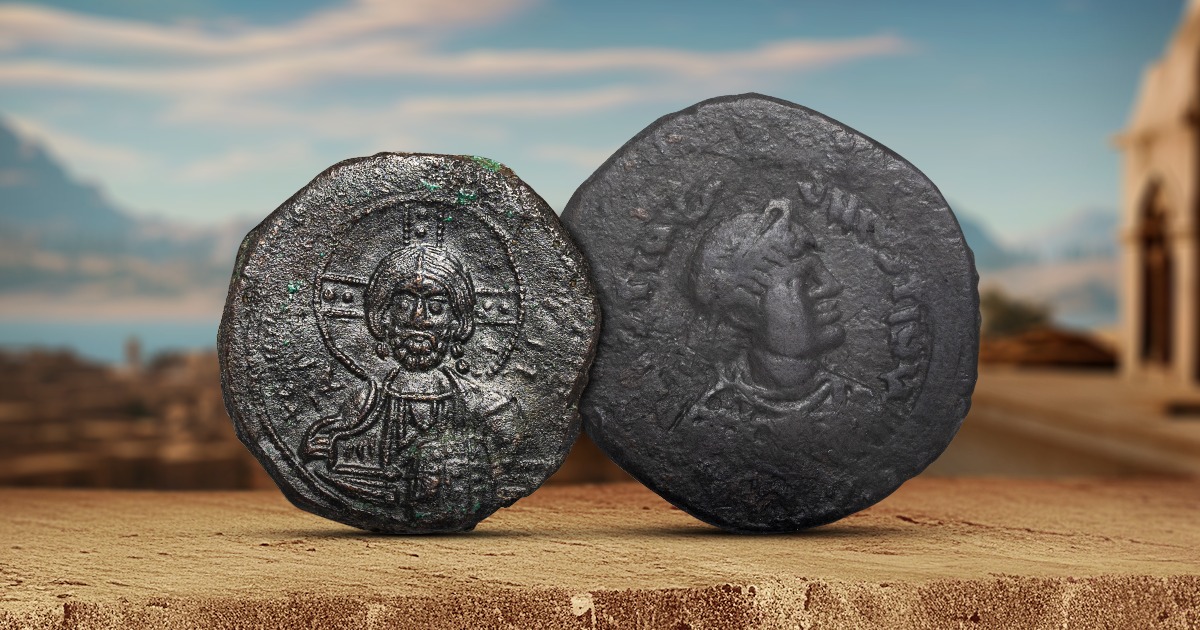
The Byzantine follis (plural: folles) was a bronze coin issued from the late 5th century to the 11th century. It was central to the Byzantine Empire’s coinage system, issued from the early age of the Empire until it was replaced by the tetarteron. The Latin word follis originally referred to a bag or purse of coins but came to represent a 40-nummus coin under Emperor Anastasius I (491–518 AD). His 498 AD reform sought to fix inflation and unify the currency system with large, clearly marked bronze denominations, including the follis, half-follis, quarter-follis, and smaller units. This established the framework for Byzantine bronze coinage, which was issued for centuries.
Issuance and Evolution
Byzantine folles were first issued in large sizes, featuring the Greek letter “M” to indicate their value of 40 nummi. They replaced smaller, impractical issues and simplified transactions for everyday use. Over time, they saw changes in design and weight, reflecting economic and political shifts. The follis was minted in high volumes so it could replace the former bronze coinage system, which was inconsistent in weight.
The system was expanded with fractional half-follis, quarter-follis, and smaller units like the decanummium (10 nummi) and pentanummium (5 nummi). These were minted in both the imperial capital and provincial centers, facilitating tax collection, troop payments, and commercial exchanges across urban and rural settings.
The coin’s physical characteristics, like weight and flan size, changed amid fluctuating copper supplies and economic pressures. As the empire faced financial struggles, the weight of the follis declined, and smaller, lower-quality flans became common. These changes continued until the reform of 1092 under Alexios I, which phased the follis out of regular circulation.
Designs and Symbolism
Obverse Designs
The obverse of early Byzantine follis coins featured a bust of the reigning emperor in profile or facing forward. The emperor was often shown in military garb or ceremonial robes, with a helmet, crown, or diadem, and occasionally holding symbols of power like a globus cruciger or spear. These depictions conveyed imperial strength, legitimacy, and divine favor. Accompanying inscriptions identified the emperor by name and included imperial titles in abbreviated Greek or Latin forms.
During the anonymous follis period (969 to 1092 AD), the obverse underwent a complete transformation. This transformed the obverse from an imperial bust to a depiction of Christ Pantokrator, a frontal image of Christ with a halo and a Gospel book. Inscriptions on the reverse read IC XC (Jesus Christ) or EMMANOUHL (God With Us), reinforcing Christ as the ruler of the empire.
Reverse Designs
The reverse of early follis designs featured a large Greek letter “M” for 40 nummi, which was centered to indicate the denomination. These were surrounded by other design elements, including crosses, mint marks, and regnal years. The purpose was to facilitate easy recognition and emphasize the emperor’s administrative reach.
Anonymous folles introduced more explicitly religious inscriptions on the reverse. These include lines such as +IHSUS XRISTUS BASILEU BASILE (Jesus Christ, King of Kings), often arranged across several lines and bordered by other symbols like stars, crosses, or geometric flourishes. Later issues expanded these motifs, adding Marian imagery and liturgical references.
Transition to Anonymous Folles
The shift to the anonymous follis began under John I Tzimiskes around 969. This deliberate break from imperial portraiture emphasized Jesus Christ as the sole authority. This reflected a spiritual and political statement during a time of military and internal strife, presenting continuity and divine legitimacy above personal rule.
Classification and Variation
Anonymous folles are grouped into Classes A through K. Class A is divided into A1, A2, and A3, each showing small but significant changes in Christ’s features, ornamentation, and overall execution. Later classes introduced new figures such as the Virgin Mary (Class G) and symbolic motifs like the Patriarchal Cross (Class H). The final classes (I to K), attributed to Nikephoros III and Alexios I, saw a decline in flan quality and metal content.
These stylistic details help numismatists date specimens and attribute them to particular reigns. Overstrikes and regional mint variations also provide insights into production timelines and the economic strategies of the empire. These were usually placed at the center and flanked by marks indicating the regnal year, mint location, or additional religious symbols, most commonly a cross.
These religious designs served both theological and political purposes, shifting authority from the emperor to Christ. Variations in ornamentation, inscriptions, and layout also provide valuable data for numismatists.
Broader Byzantine Coin System
Byzantine currency operated on a multi-metal system:
- Gold solidus: The gold solidus was introduced by Constantine I and remained a global standard.
- Hyperpyron: The hyperpryon replaced the solidus after 1092.
- Silver miliaresion: Medium-value coinage.
- Copper coins: Including folles and smaller denominations for everyday use.
Global Influence of Byzantine Coinage
Islamic Coinage
Islamic coinage borrowed from the designs of Byzantine and Sasanian sources. The solidus and follis were directly imitated. The Arabic fals derives from follis. Caliph Abd al-Malik’s 696 AD reform established distinct Islamic coins with Qur’anic inscriptions but retained Byzantine standards of weight and metal.
Collecting Byzantine Folles
A typical anonymous follis set includes 13 types: A1, A2, A3, and Classes B–K. Later classes (E–K) are rarer. Collectors value legible, well-struck examples, though many are overstruck and worn.
The Byzantine follis exemplifies a currency that bridged ancient Rome and the medieval Christian world. From Anastasius’ reforms to the theologically driven anonymous series, it evolved alongside the empire’s spiritual and political landscape.




